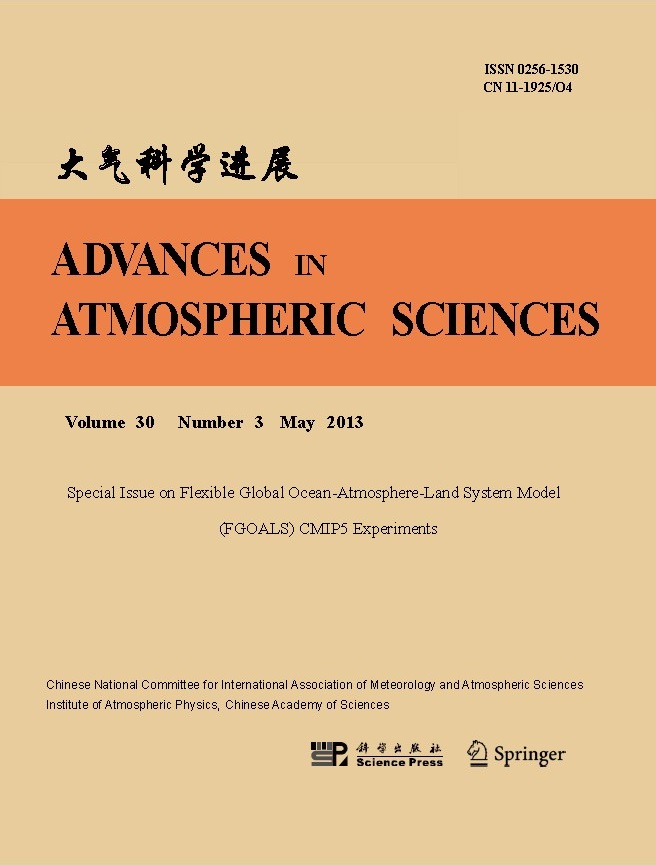| [1] |
CUI Limei, SUN Jianhua, QI Linlin, LEI Ting,
2011: Application of ATOVS Radiance-Bias Correction to Typhoon Track Prediction with Ensemble Kalman Filter Data Assimilation, ADVANCES IN ATMOSPHERIC SCIENCES, 28, 178-186.
doi: 10.1007/s00376-010-9145-9
|
| [2] |
LI Shan, RONG Xingyao, LIU Yun, LIU Zhengyu, Klaus FRAEDRICH,
2013: Dynamic Analogue Initialization for Ensemble Forecasting, ADVANCES IN ATMOSPHERIC SCIENCES, 30, 1406-1420.
doi: 10.1007/s00376-012-2244-z
|
| [3] |
Lei HAN, Mingxuan CHEN, Kangkai CHEN, Haonan CHEN, Yanbiao ZHANG, Bing LU, Linye SONG, Rui QIN,
2021: A Deep Learning Method for Bias Correction of ECMWF 24–240 h Forecasts, ADVANCES IN ATMOSPHERIC SCIENCES, 38, 1444-1459.
doi: 10.1007/s00376-021-0215-y
|
| [4] |
Donglei SHI, Guanghua CHEN, Ke WANG, Xinxin BI, Kexin CHEN,
2020: Evaluation of Two Initialization Schemes for Simulating the Rapid Intensification of Typhoon Lekima (2019), ADVANCES IN ATMOSPHERIC SCIENCES, 37, 987-1006.
doi: 10.1007/s00376-020-2038-7
|
| [5] |
CHEN Hong, LIN Zhaohui,
2006: A Correction Method Suitable for Dynamical Seasonal Prediction, ADVANCES IN ATMOSPHERIC SCIENCES, 23, 425-430.
doi: 10.1007/s00376-006-0425-3
|
| [6] |
Banglin ZHANG, Vijay TALLAPRAGADA, Fuzhong WENG, Jason SIPPEL, Zaizhong MA,
2016: Estimation and Correction of Model Bias in the NASA/GMAO GEOS5 Data Assimilation System: Sequential Implementation, ADVANCES IN ATMOSPHERIC SCIENCES, 33, 659-672.
doi: 10.1007/ s00376-015-5155-y
|
| [7] |
Chenwei SHEN, Qingyun DUAN, Chiyuan MIAO, Chang XING, Xuewei FAN, Yi WU, Jingya HAN,
2020: Bias Correction and Ensemble Projections of Temperature Changes over Ten Subregions in CORDEX East Asia, ADVANCES IN ATMOSPHERIC SCIENCES, 37, 1191-1210.
doi: 10.1007/s00376-020-0026-6
|
| [8] |
Keon-Tae SOHN, H. Joe KWON, Ae-Sook SUH,
2003: Prediction of Typhoon Tracks Using Dynamic Linear Models, ADVANCES IN ATMOSPHERIC SCIENCES, 20, 379-384.
doi: 10.1007/BF02690796
|
| [9] |
Jiawen ZHU, Xiaodong ZENG, Minghua ZHANG, Yongjiu DAI, Duoying JI, Fang LI, Qian ZHANG, He ZHANG, Xiang SONG,
2018: Evaluation of the New Dynamic Global Vegetation Model in CAS-ESM, ADVANCES IN ATMOSPHERIC SCIENCES, 35, 659-670.
doi: 10.1007/s00376-017-7154-7
|
| [10] |
Lei ZHU, Zhiyong MENG, Yonghui WENG, Fuqing ZHANG,
2022: Assimilation of All-sky Geostationary Satellite Infrared Radiances for Convection-Permitting Initialization and Prediction of Hurricane Joaquin (2015), ADVANCES IN ATMOSPHERIC SCIENCES, 39, 1859-1872.
doi: 10.1007/s00376-022-2015-4
|
| [11] |
XUE Hai-Le, SHEN Xue-Shun, CHOU Ji-Fan,
2013: A Forecast Error Correction Method in Numerical Weather Prediction by Using Recent Multiple-time Evolution Data, ADVANCES IN ATMOSPHERIC SCIENCES, 30, 1249-1259.
doi: 10.1007/s00376-013-2274-1
|
| [12] |
Lili LEI, Yangjinxi GE, Zhe-Min TAN, Yi ZHANG, Kekuan CHU, Xin QIU, Qifeng QIAN,
2022: Evaluation of a Regional Ensemble Data Assimilation System for Typhoon Prediction, ADVANCES IN ATMOSPHERIC SCIENCES, 39, 1816-1832.
doi: 10.1007/s00376-022-1444-4
|
| [13] |
Yuanyuan WANG, Zhenghui XIE, Binghao JIA,
2016: Incorporation of a Dynamic Root Distribution into CLM4.5: Evaluation of Carbon and Water Fluxes over the Amazon, ADVANCES IN ATMOSPHERIC SCIENCES, 33, 1047-1060.
doi: 10.1007/s00376-016-5226-8
|
| [14] |
Keon-Tae SOHN, Deuk-Kyun RHA, Young-Kyung SEO,
2003: The 3-Hour-Interval Prediction of Ground-Level Temperature in South Korea Using Dynamic Linear Models, ADVANCES IN ATMOSPHERIC SCIENCES, 20, 575-582.
doi: 10.1007/BF02915500
|
| [15] |
MA Jiehua, WANG Huijun, FAN Ke,
2015: Dynamic Downscaling of Summer Precipitation Prediction over China in 1998 Using WRF and CCSM4, ADVANCES IN ATMOSPHERIC SCIENCES, 32, 577-584.
doi: 10.1007/s00376-014-4143-y
|
| [16] |
Abebe Kebede, Kirsten Warrach-sagi, Thomas Schwitalla, Volker Wulfmeyer, Tesfaye Amdie, Markos Ware,
2024: Assessment of Seasonal Rainfall Prediction in Ethiopia: Evaluating a Dynamic Recurrent Neural Network to Downscale ECMWF-SEAS5 Rainfall, ADVANCES IN ATMOSPHERIC SCIENCES.
doi: 10.1007/s00376-024-3345-1
|
| [17] |
HAN Leqiong, LI Shuanglin, LIU Na,
2014: An Approach for Improving Short-Term Prediction of Summer Rainfall over North China by Decomposing Interannual and Decadal Variability, ADVANCES IN ATMOSPHERIC SCIENCES, 31, 435-448.
doi: 10.1007/s00376-013-3016-0
|
| [18] |
Jianping LI, Tiejun XIE, Xinxin TANG, Hao WANG, Cheng SUN, Juan FENG, Fei ZHENG, Ruiqiang DING,
2022: Influence of the NAO on Wintertime Surface Air Temperature over East Asia: Multidecadal Variability and Decadal Prediction, ADVANCES IN ATMOSPHERIC SCIENCES, 39, 625-642.
doi: 10.1007/s00376-021-1075-1
|
| [19] |
Na LI, Lingkun RAN, Dongdong SHEN, Baofeng JIAO,
2021: An Experiment on the Prediction of the Surface Wind Speed in Chongli Based on the WRF Model: Evaluation and Calibration, ADVANCES IN ATMOSPHERIC SCIENCES, 38, 845-861.
doi: 10.1007/s00376-021-0201-4
|
| [20] |
Huijun HUANG, Bin HUANG, Li YI, Chunxia LIU, Jing TU, Guanhuan WEN, Weikang MAO,
2019: Evaluation of the Global and Regional Assimilation and Prediction System for Predicting Sea Fog over the South China Sea, ADVANCES IN ATMOSPHERIC SCIENCES, 36, 623-642.
doi: 10.1007/s00376-019-8184-0
|















 AAS Website
AAS Website 
 AAS WeChat
AAS WeChat 
 DownLoad:
DownLoad: